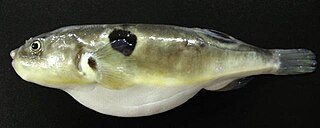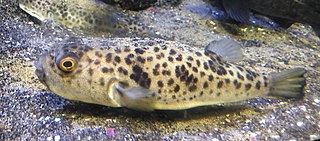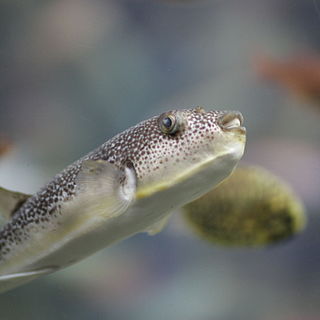In biology, taxonomy is the scientific study of naming, defining (circumscribing) and classifying groups of biological organisms based on shared characteristics. Organisms are grouped into taxa and these groups are given a taxonomic rank; groups of a given rank can be aggregated to form a more inclusive group of higher rank, thus creating a taxonomic hierarchy. The principal ranks in modern use are domain, kingdom, phylum, class, order, family, genus, and species. The Swedish botanist Carl Linnaeus is regarded as the founder of the current system of taxonomy, as he developed a ranked system known as Linnaean taxonomy for categorizing organisms and binomial nomenclature for naming organisms.

The Curculionidae are a family of weevils, commonly called snout beetles or true weevils. They are one of the largest animal families with 6,800 genera and 83,000 species described worldwide. They are the sister group to the family Brentidae.

Takifugu, also known by the Japanese name fugu, is a genus of pufferfish with 25 species, most of which are native to salt and brackish waters of the northwest Pacific, but a few species are found in freshwater in Asia or more widely in the Indo-Pacific region. Their diet consists mostly of algae, molluscs, invertebrates and sometimes crustaceans.

Pseudacris is a genus of frogs in the family Hylidae found in North America ranging from the Pacific coastline to the Atlantic.

The fraternal myotis is a species of vesper bat native to East Asia.

Takifugu rubripes, commonly known as the Japanese puffer, Tiger puffer, or torafugu, is a pufferfish in the genus Takifugu. It is distinguished by a very small genome that has been fully sequenced because of its use as a model species and is in widespread use as a reference in genomics.

The Pomona roundleaf bat, Pomona leaf-nosed bat, or Andersen's leaf-nosed bat is a species of bat in the family Hipposideridae that is endemic to India.

The grass puffer, or Kusa-fugu, is a species of fish in the pufferfish family (Tetraodontidae). This common to abundant species is found in the northwest Pacific Ocean in China, Japan, Korea, the Philippines and Vietnam. It is primarily found in coastal waters, ranging to depths of 20 m (66 ft), but is often seen in brackish water and has also been recorded briefly entering freshwater. The grass puffer reaches up to 15 cm (6 in) in length.
In biology, a phylum is a level of classification or taxonomic rank below kingdom and above class. Traditionally, in botany the term division has been used instead of phylum, although the International Code of Nomenclature for algae, fungi, and plants accepts the terms as equivalent. Depending on definitions, the animal kingdom Animalia contains about 31 phyla, the plant kingdom Plantae contains about 14 phyla, and the fungus kingdom Fungi contains about 8 phyla. Current research in phylogenetics is uncovering the relationships among phyla within larger clades like Ecdysozoa and Embryophyta.

The nematodes, roundworms or eelworms constitute the phylum Nematoda. They are a diverse animal phylum inhabiting a broad range of environments. Most species are free-living, feeding on microorganisms, but there are many that are parasitic. The parasitic worms (helminths) are the cause of soil-transmitted helminthiases.
A species (pl. species) in biology is often defined as the largest group of organisms in which any two individuals of the appropriate sexes or mating types can produce fertile offspring, typically by sexual reproduction. It is the basic unit of classification and a taxonomic rank of an organism, as well as a unit of biodiversity. Other ways of defining species include their karyotype, DNA sequence, morphology, behaviour, or ecological niche. In addition, paleontologists use the concept of the chronospecies since fossil reproduction cannot be examined.

The horsehair crab, Erimacrus isenbeckii, is a species of crab which is found mainly in the Northwest Pacific, around the Hokkaido coast in the Sea of Okhotsk and the Western Bering Sea and is an important commercial species used in Japanese cuisine. Despite the importance of the species, biological studies are usually specialized and limited. The catch for the species reached a peak in the 1950s at 27,000 tons and has decreased since, reaching 2,000 tons in 2003. Due to the commercial importance of the species, many stock enhancement programs have been utilized to help maintain a successful fishery. The species is commonly found on sandy benthic environments from shallow water to depths of up to 350 meters.

Takifugu obscurus or the obscure pufferfish is a species of euryhaline, anadromous pufferfish first described by T. Abe in 1949. It has been categorized by the IUCN as a least-concern species globally since 2014; in South Korea, it is however classified as an endangered species due to overfishing of its endemic populations. The Catalogue of Life lists no subspecies of Takifugu obscurus. The species prefers deeper, clearer areas of brackish and fresh water, and is found in estuaries, as well as rivers and tributaries thereof such as the South Korean rivers Geum, Han, and Imjin, or the Tamsui River. The species is endemic to North and South Korea, the Sea of Japan, and the East and South China Seas. Uses of Takifugu obscurus include human consumption, use in animal testing, and owning specimens as pets. As with most species of pufferfish, several organs of Takifugu obscurus contain tetrodotoxin, making it potentially poisonous if not prepared safely by trained persons.

Takifugu alboplumbeus, sometimes known as the grey-spotted puffer, is a species of pufferfish in the family Tetraodontidae. It is a marine species native to the Indo-Pacific that reaches 23 cm SL. It is known to be highly toxic.
Takifugu coronoidus is a species of pufferfish in the family Tetraodontidae. It is a brackish-water species known from China that was first described by Y. Li and C. S. Ni in 1992. In Chinese, the species is known as "晕环多纪鲀", which translates to "halo pufferfish".

Takifugu ocellatus, sometimes known as the ocellated puffer or the orange-saddle puffer, is a species of anadromous pufferfish in the family Tetraodontidae. It is native to China and Vietnam. Juveniles of the species occur in brackish and freshwater environments, but adults are marine. This species is noted to be fatally poisonous to humans if consumed. It reaches 15 cm in total length.

Takifugu pardalis, known as the panther puffer, is a species of pufferfish in the family Tetraodontidae. It is a marine species native to the Northwest Pacific, where it ranges from Hakodate in Japan to the Yellow Sea and the East China Sea. It is demersal, occurring in coastal rocky areas, and reaches 30 cm SL. It is known to be poisonous. Both the scientific and common name of this species reference its distinctive spotted pattern, which resembles that of a leopard.

Takifugu snyderi, known as shōsai-fugu in Japanese, is a species of pufferfish in the family Tetraodontidae. It is a marine species native to Japan, the Yellow Sea, and the South China Sea. It is demersal and reaches 30 cm SL. While the ovaries, skin, liver, and intestines of the species are extremely toxic, the testes and flesh are thought to be less hazardous, and species of the genus Takifugu are frequently consumed as fugu.

Iguanodectidae is a family of freshwater fish in the order Characiformes that lives in South America. It is home to the subfamily Iguanodectinae and the monotypic Bryconops clade. Several species in the family, such as the green line lizard tetra, the tailspot tetra, and the orangefin tetra, are sometimes taken as aquarium fish.













